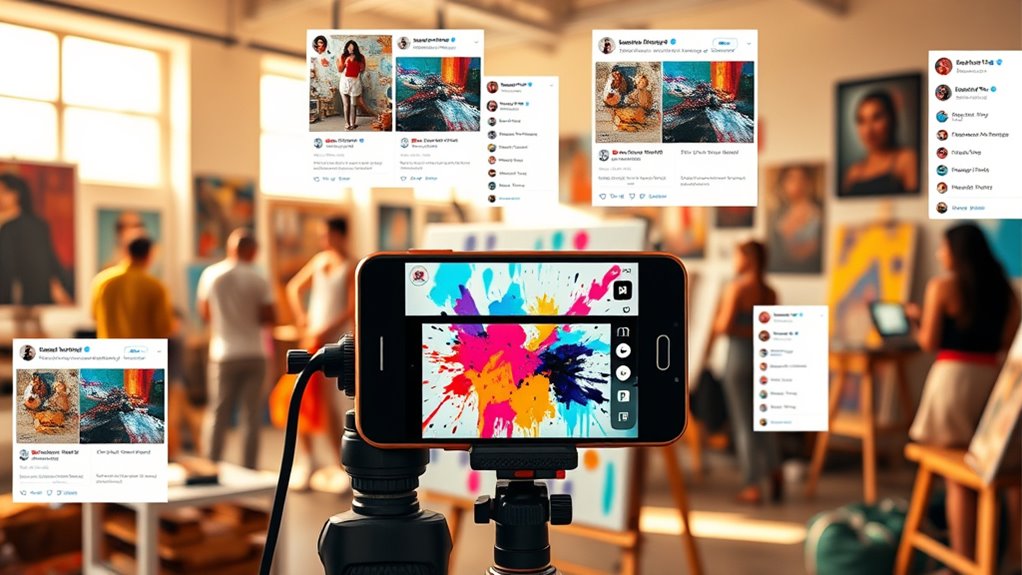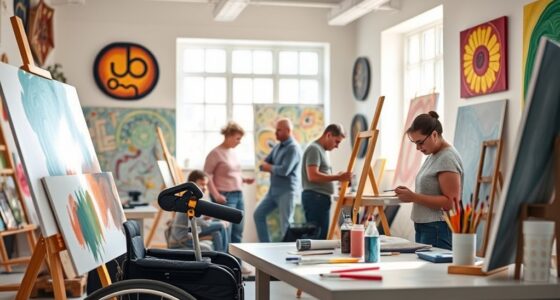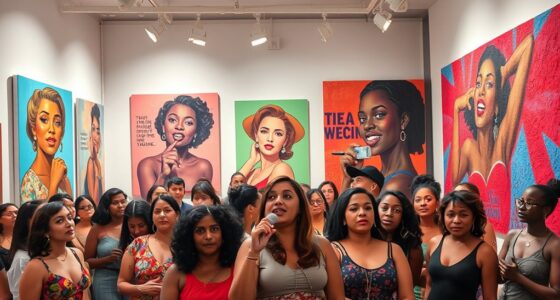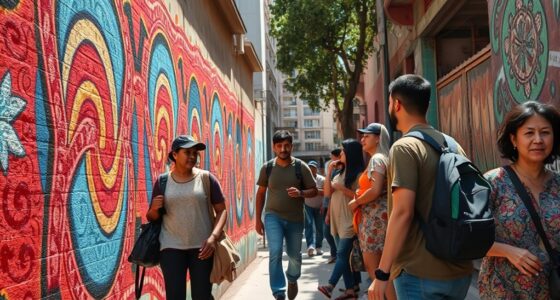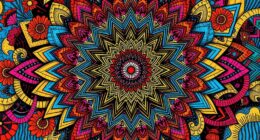Social media transforms how you create, share, and grow as an artist by democratizing access and expanding your global reach. You can directly showcase your work, engage with audiences through live features, and build your personal brand with strategic hashtags. Viral trends and user content grow your visibility organically, offering new opportunities in virtual exhibitions and digital art. Keep exploring, and you’ll discover how these platforms can open your artistic potential even further.
Key Takeaways
- Social media democratizes art access, enabling independent artists to reach global audiences without traditional gatekeepers.
- Platforms facilitate real-time engagement, fostering personal connections and immediate feedback between artists and viewers.
- Hashtag strategies and viral trends boost visibility, helping artists grow their personal brands organically.
- Virtual exhibitions and digital tools expand artistic opportunities beyond physical limitations and geographic barriers.
- AI, NFTs, and digital trends reshape art ownership, creation, and promotion, influencing industry practices and artist monetization.
Democratization of Artistic Access
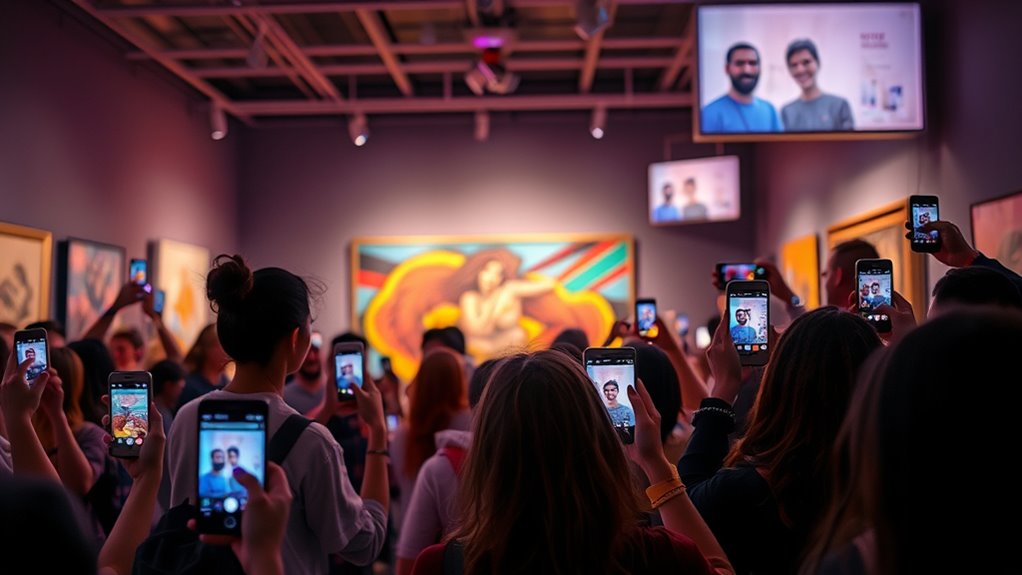
How has social media transformed access to the arts? It lets you share your work directly with audiences, bypassing galleries, publishers, and record labels. Platforms like Instagram, TikTok, YouTube, and X give creators from all backgrounds the chance to build careers independently. Viral posts can replace months or years of traditional promotion, speeding up recognition and opportunities. Musicians grow fan bases on SoundCloud and YouTube, while visual artists and writers showcase their work globally without intermediaries. Social media broadens the types of art that gain visibility, including those outside mainstream channels. It also helps underrepresented creators find audiences and support online. By reducing geographic and socioeconomic barriers, social media democratizes art, giving everyone a fairer shot at recognition and success. As of October 2023, 4.95 billion people worldwide use social media, making it a powerful tool for artistic dissemination and community building. Additionally, the ability to share digital art and multimedia content instantly has revolutionized how artists experiment and innovate in their craft. These platforms also facilitate community engagement, fostering supportive networks that encourage diverse artistic expression. Moreover, the rise of social media has led to new forms of digital collaboration, enabling artists to work together across borders and share ideas in real time. The integration of emerging technologies continues to expand creative possibilities and redefine artistic boundaries.
Expanding Global Reach Through Platforms
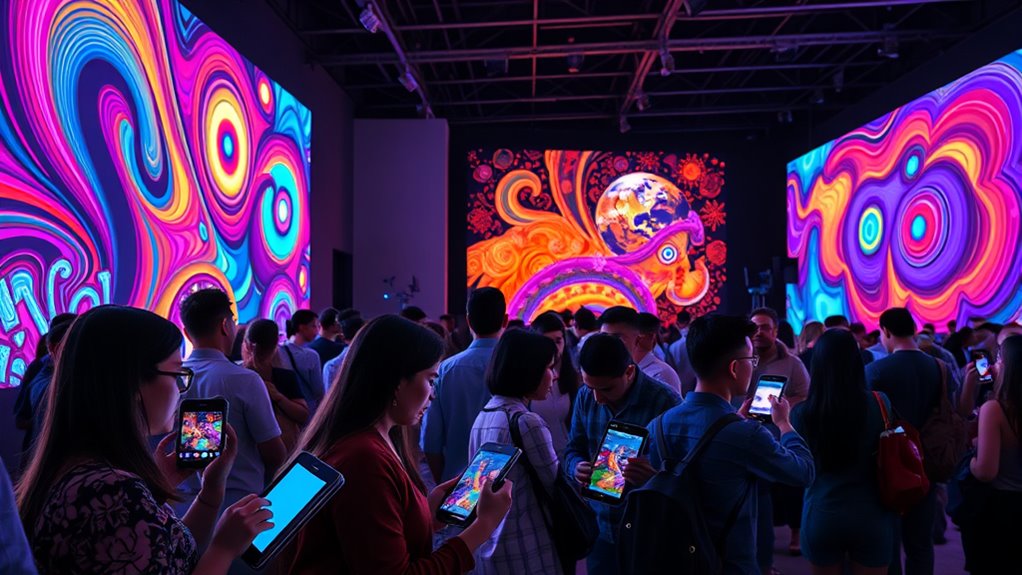
Social media platforms have dramatically expanded artists’ ability to reach a global audience. With over 5 billion users worldwide, your work can now be seen by diverse communities across continents, and this number is expected to grow. Platforms like Instagram, TikTok, Pinterest, and LinkedIn allow you to target specific demographics, showcase your art, and connect directly with fans, collectors, and industry professionals. You can build relationships without intermediaries, using tools like messaging and live streams to foster trust and engagement. AI algorithms personalize content, increasing your work’s visibility across borders. This expanded Global social media usage continues to rise, further amplifying artists’ exposure and opportunities on these platforms. Additionally, understanding how social media algorithms work can help you optimize your content for even greater reach. This expanded reach enables you to tap into international markets, collaborate globally, and turn social media into a powerful tool for broadening your audience and growing your artistic presence worldwide.
Enhancing Engagement With Live Features
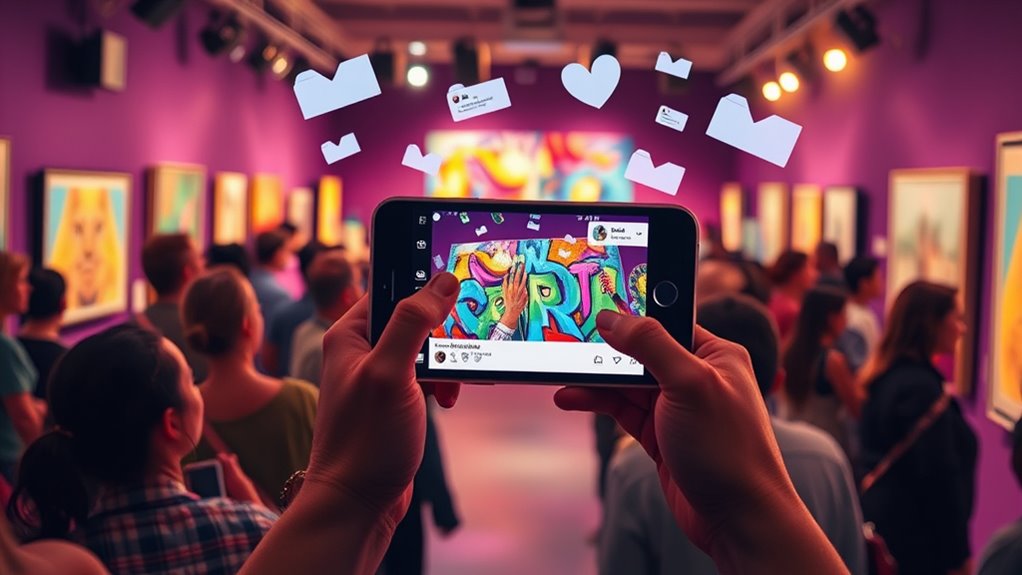
Live features boost your engagement by enabling real-time interaction, making viewers feel more connected to your work. As audiences comment and ask questions instantly, you can respond and adjust, fostering a personal bond. This immediate connection encourages more participation and strengthens your community. Research shows that 82% of arts organizations use social media to engage audiences before, during, and after events, highlighting the importance of live interaction in building lasting relationships. Incorporating interactive elements like polls or Q&A sessions can further enhance the sense of authenticity and immediacy. Leveraging animated content can also capture viewers’ attention and make your live sessions more dynamic. Additionally, integrating glamping-inspired themes can inspire creative visuals and storytelling that resonate with diverse audiences. Utilizing audience engagement techniques can significantly boost viewer involvement and foster a more vibrant community atmosphere. Implementing professional voiceover techniques can also add a polished and compelling layer to your live broadcasts, making your content more memorable.
Real-Time Interaction Benefits
Real-time interaction through live features offers artists a powerful way to boost their visibility and deepen audience engagement. When you go live, you reach a broader audience instantly, increasing your exposure. Interactive elements like Q&A sessions and polls foster higher engagement rates, especially on platforms like TikTok and Instagram. Live streaming helps you build a community around your work, cultivating loyalty and support. It also provides immediate feedback, allowing you to refine your creative process on the spot. Additionally, audience engagement strategies enhance your ability to connect meaningfully with viewers and foster long-term relationships. Plus, live features open marketing opportunities, such as announcing new projects or exclusive offers. According to industry data, platforms like TikTok and Instagram are among the top channels for live interactions. You can:
- Reach new audiences in real-time
- Increase engagement with interactive content
- Receive instant feedback on your work
- Promote upcoming projects directly
- Leveraging social media engagement can further amplify your reach and foster stronger relationships with your audience. Incorporating platform operating hours awareness ensures you schedule your live sessions during optimal times for maximum participation. Utilizing privacy policies and cookie management ensures a transparent and respectful interaction environment that benefits both artists and viewers. Additionally, understanding the best practices for live streaming can help maximize your impact and viewer retention during your sessions.
Increased Audience Participation
By engaging audiences directly during live streams, artists can foster a deeper sense of participation and connection. You can share your creative process in real time, attracting a broader, more diverse audience. Social media platforms like Facebook, Instagram, and YouTube make it easier to host live art events, workshops, and gallery tours without physical barriers. Interactive features such as live chat, Q&A, and audience suggestions let viewers influence your work, boosting engagement. Live streams often outperform static posts in generating interest and participation. Plus, real-time analytics help you understand who’s watching and what they enjoy, allowing you to tailor future content. This increased participation builds a more inclusive, dynamic art community where audiences feel involved and invested in your creative journey. Live streaming also broadens audience reach through immediate online exposure, connecting artists with viewers around the world. Additionally, understanding the emotional readiness of your audience can enhance their engagement and loyalty during these interactive sessions.
Building Personal Connections
Building personal connections has become easier through live features on social media, allowing artists to engage directly with their audiences. These real-time interactions foster trust and loyalty, making followers feel more connected. TikTok leads with up to 44.8% engagement, especially for smaller pages, thanks to live streams and carousels. Instagram artist spotlights generate high engagement—around 6.8%—and become more impactful with live Q&A sessions. Facebook and X may have lower engagement, but video content and snackable visuals still draw audiences when used strategically. Social media acts as a substitute for face-to-face connections, enabling artists to share work, ideas, and updates directly with fans and curators. This online engagement often translates into increased attendance at live events and exhibitions. Additionally, leveraging audience engagement strategies like interactive features can significantly enhance connection and visibility. Incorporating technology advancements such as live streaming tools can further improve real-time interactions and overall engagement. Utilizing content diversity ensures that artists maintain audience interest across different platforms and formats, which is especially important given the influence of heartfelt messages and personal stories in strengthening connections. The use of visual content like images and videos, aligned with innovative hull designs and propulsion methods, can also boost engagement by appealing visually to audiences.
Building Personal Brands With Hashtags
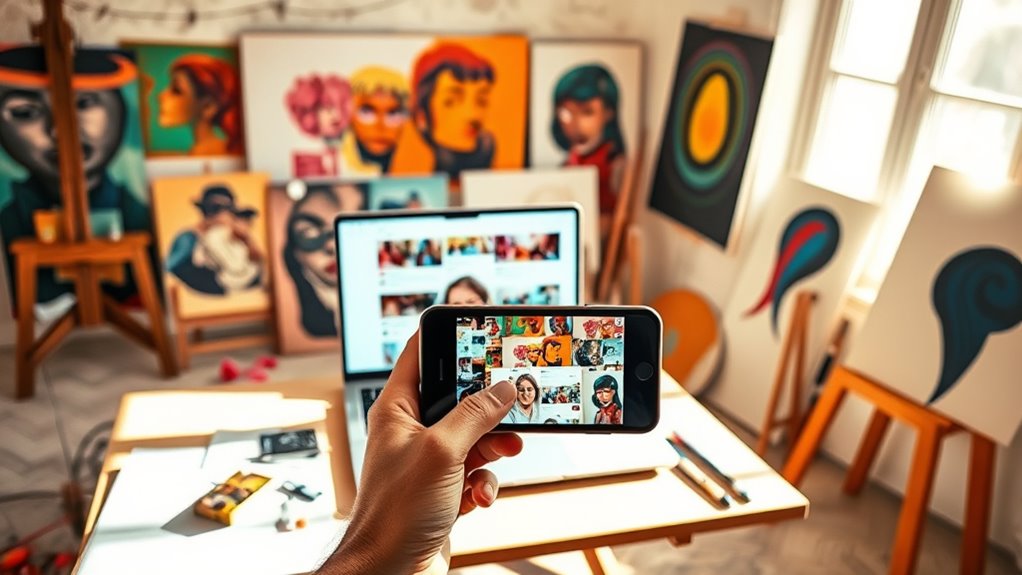
Using hashtags strategically is essential for building your personal brand and standing out among other artists. Consistently applying branded and niche-specific tags helps reinforce your identity and attract the right followers. When you craft a clear hashtag strategy, you boost visibility and create a community around your work.
Hashtag Strategy Significance
A well-crafted hashtag strategy is essential for artists aiming to amplify their personal brand on social media. Using hashtags correctly can double your engagement and expand your reach markedly. Profiles with 10,000 to 100,000 followers see about 21% more interaction per post when hashtags are used. For smaller accounts under 5,000 followers, placing hashtags in captions instead of comments boosts reach by up to 36%. Most brands put hashtags in captions, which correlates with higher engagement. Limiting hashtags to three or fewer per post often yields better results. To optimize, you should:
- Place hashtags directly in captions for immediate visibility
- Use a mix of popular and niche hashtags
- Research trending tags relevant to your art
- Track performance to refine your strategy
Consistent Branding Practices
Consistent branding across social media platforms helps artists establish a recognizable presence that resonates with their audience. When your branding is uniform, fans can easily identify your style and message, boosting your visibility and making you more memorable. Regular posting and engaging with followers strengthen your connection, fostering loyalty and trust. Tailoring content to each platform’s format ensures your message stays relevant while maintaining overall brand cohesion. This consistency also helps control your narrative, shaping how fans and critics perceive you. Plus, a strong, clear brand opens doors for collaborations, merchandise, and endorsements, expanding your income streams. By building a cohesive personal brand, you create a lasting legacy that elevates your artistic career and distinguishes you in a crowded market.
Amplifying Art Through User Content
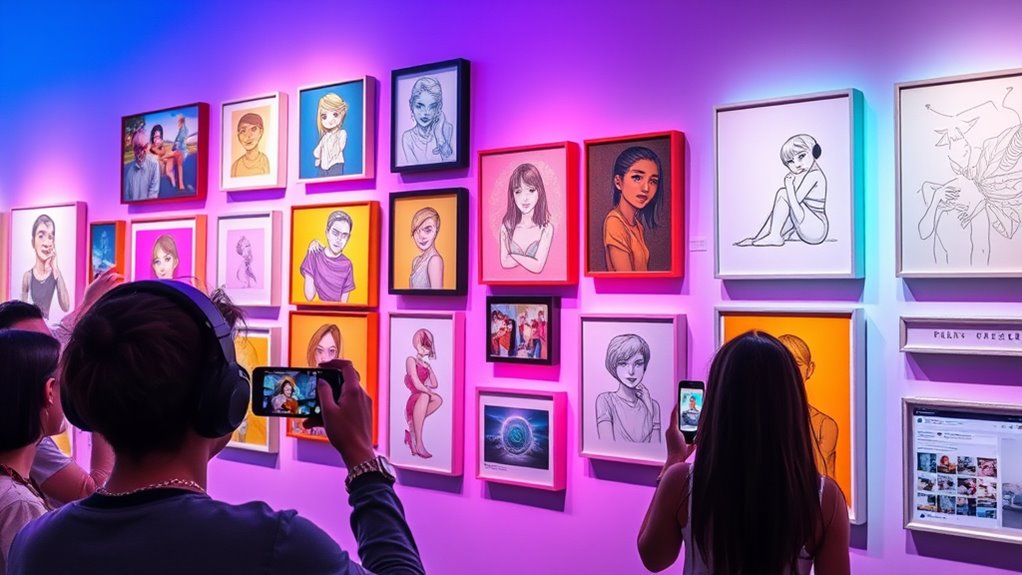
Social media platforms serve as powerful tools for artists to amplify their work through user-generated content. When you share your art, others can repost, comment, and create their own content inspired by your work, expanding your reach. This organic sharing boosts visibility and attracts new followers and potential buyers. Brands often partner with artists for user-generated campaigns, providing additional income streams through sponsored posts and collaborations. Platforms’ analytics help you track engagement, optimize your content, and increase revenue. You can also build a loyal community by sharing behind-the-scenes or process videos, fostering authentic connections. As a result, your art gains more exposure, credibility, and opportunities for growth, all driven by active participation and community-driven sharing.
Sharing your art on social media amplifies your reach, builds community, and opens up new opportunities for growth and collaboration.
- Reposts and shares from followers and fans
- Collaborations with brands and influencers
- Behind-the-scenes and process videos
- Community-driven feedback and engagement
Viral Trends and Organic Growth Strategies

Harnessing viral trends and organic growth strategies can substantially boost your art’s visibility on social media. By identifying popular hashtags and trends on platforms like Instagram and TikTok, you can tap into what’s currently viral. TikTok excels at short-form, eye-catching content, while Instagram remains a visual hub for artists. Participating in challenges or collaborating with other artists increases your chances of going viral and reaching new audiences. Engaging your followers through interactive content — like tutorials or behind-the-scenes posts — encourages sharing and remixing, fueling further growth. Consistently creating authentic stories about your artistic process helps build a loyal community. Additionally, leveraging analytics tools allows you to understand your audience better and refine your strategies, ensuring your growth remains organic and sustainable.
Virtual Exhibitions and Digital Art Forms
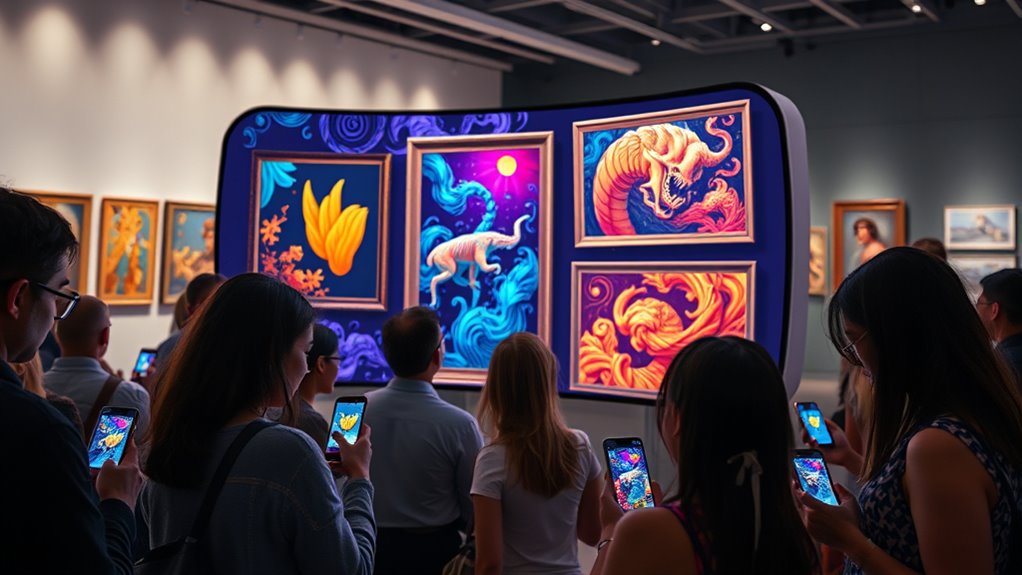
Virtual exhibitions are transforming how artists showcase their work by making art more accessible to a global audience. You can reach viewers anywhere, breaking down geographic barriers. Platforms like Artsteps and Kunstmatrix create immersive 3D environments, allowing you to craft engaging experiences. They also cut costs compared to physical shows, giving you more flexibility with your budget. Plus, you can personalize your exhibits with interactive features like audio guides or video demos, adding depth to your presentation. These virtual spaces foster community through chat functions and live Q&As, enabling real-time interaction. Imagine viewers exploring your work in a virtual gallery, engaging directly with your art and ideas, all while expanding your reach beyond traditional limits. It’s a new frontier for showcasing creativity and connecting with audiences worldwide.
Career Opportunities and Challenges in the Digital Space
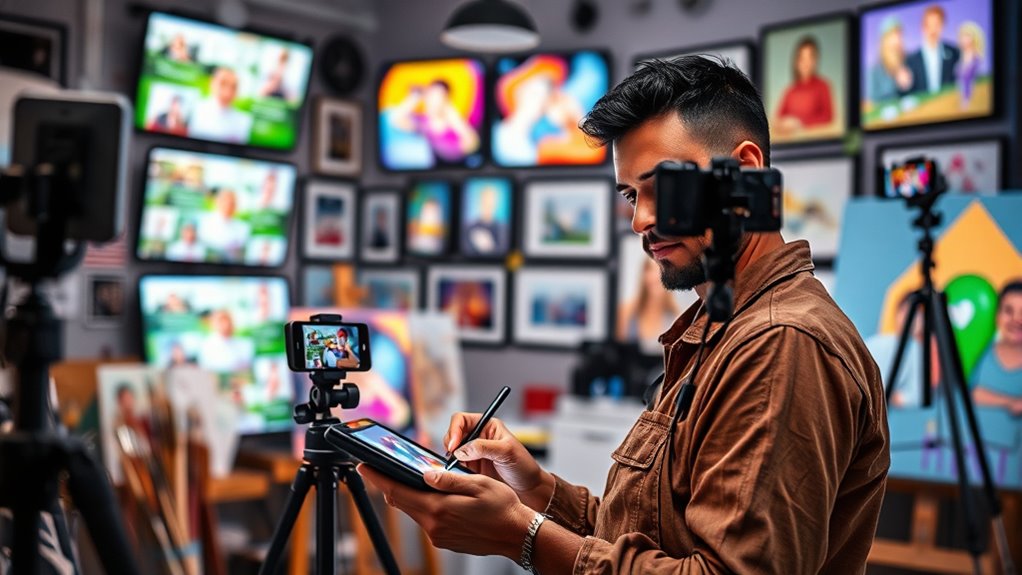
The rise of digital art has opened up new career paths and opportunities for artists willing to adapt to the online landscape. You can find jobs in film, video games, advertising, and software design, with annual openings around 87,900 due to growth and replacements. While the median wage is about $53,180, salaries vary based on roles like FX or digital production artists. However, competition is fierce—you need a strong portfolio, updated tech skills, and formal training to stand out. Building a compelling digital portfolio and engaging with online communities boost your visibility. Continuous learning and networking are essential to stay relevant. Despite challenges, expanding your skills in the digital space can lead to stable job prospects and diverse opportunities in this evolving industry.
Future Trends and Ethical Considerations
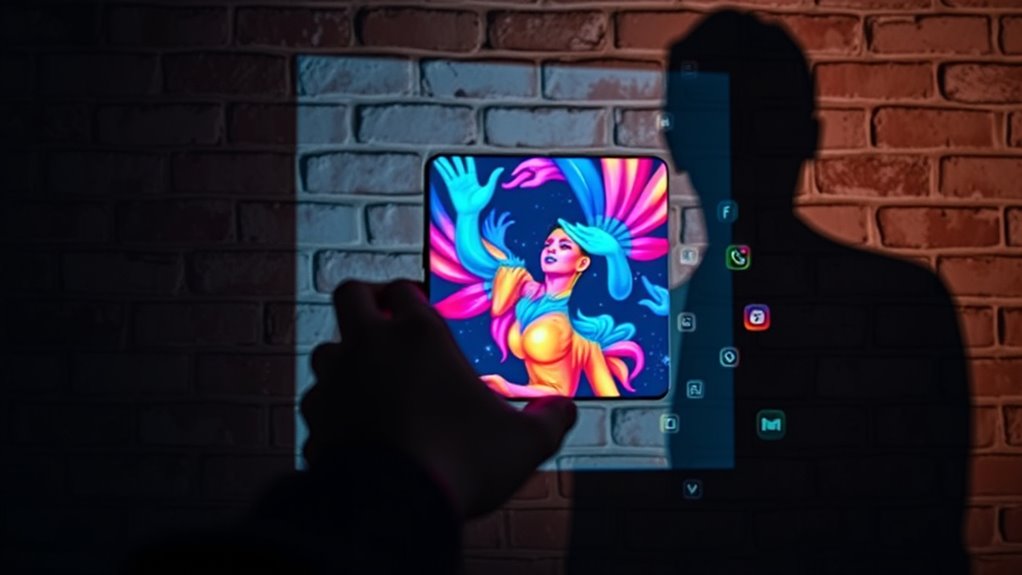
As digital art continues to evolve, emerging technologies like AI and blockchain are shaping future trends that will markedly impact artists and the art market. You’ll see AI assisting in creating and promoting work, boosting both efficiency and creativity. Digital collectibles will offer new ways for you to monetize art, while meme culture and viral trends become tools for audience engagement. Mixed media will dominate, encouraging experimentation across different mediums. Climate-themed art will gain prominence, raising awareness about environmental issues.
- AI-driven tools enhance creative processes and marketing strategies
- Blockchain and NFTs redefine ownership and provenance
- Viral trends help artists reach wider audiences
- Ethical issues like copyright, authenticity, and data privacy become central to discussions
Frequently Asked Questions
How Do Social Media Algorithms Prioritize Art Content?
You might wonder how social media algorithms decide which art content to show you. They prioritize posts based on your past interactions, like likes and comments, and how recent the content is. If a piece gets lots of engagement quickly, it’s boosted. The platform also considers your demographics, the type of content you enjoy, and your activity habits, ensuring you see more of what interests you most.
What Are the Best Practices for Protecting Artist Copyrights Online?
Picture your artwork shining brightly on your online gallery, but shadows of theft lurk nearby. To protect your copyrights, register your work with the U.S. Copyright Office, add clear copyright notices, and watermark images. Keep digital records, follow platform rules, and share securely. Educate yourself on fair use, credit third-party content, and disable right-click. These steps create a sturdy shield, ensuring your creative light remains yours.
How Can Artists Monetize Their Social Media Presence Effectively?
You can monetize your social media presence by showcasing your art to attract commissions, sell digital products like prints or NFTs, and offer online workshops or courses. Use platforms like Patreon for recurring income and promote special events or exhibitions to boost visibility. Engage your audience with behind-the-scenes content and collaborate with influencers to expand your reach. Consistent posting and targeted strategies help turn followers into loyal customers and revenue streams.
What Role Does Influencer Marketing Play in Art Promotion?
Imagine the Renaissance, where patrons and artists collaborated. Today, influencer marketing acts as that modern patron, helping you promote your art. It boosts your visibility, connects you with niche and global audiences, and can even drive sales. By partnering with influencers, you gain credibility and expand your reach. This strategy shifts focus from traditional galleries to digital platforms, giving artists like you more control over how your work is seen and valued.
How Do Cultural Differences Affect Art Reception on Global Platforms?
Cultural differences greatly influence how you receive and interpret art on global platforms. You might see symbols and storytelling that resonate deeply or feel disconnected if unfamiliar with certain cultural contexts. Your appreciation depends on understanding and respect for diverse backgrounds. When artists thoughtfully incorporate cultural elements, you’re more likely to view their work as authentic. Conversely, superficial use or misrepresentation can lead to misunderstandings or criticism, shaping your overall perception.
Conclusion
As social media continues to weave its web around the art world, you hold the brush to shape your creative destiny. It’s a vibrant canvas where your voice echoes across borders, and your art ignites sparks of connection. Embrace the digital tide, riding its waves with boldness and authenticity. Remember, in this ever-evolving gallery, your passion is the masterpiece that transforms likes into legacy, making your artistic journey a breathtaking voyage.

